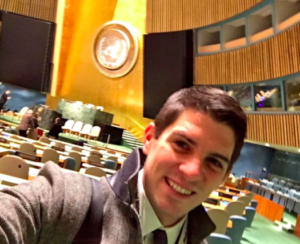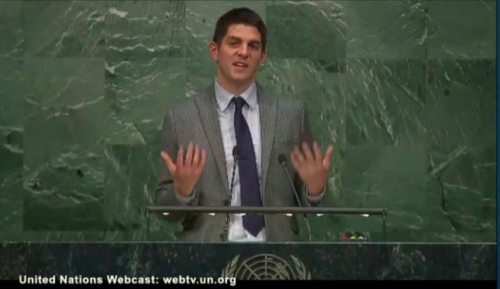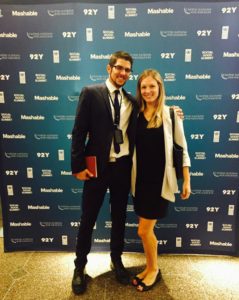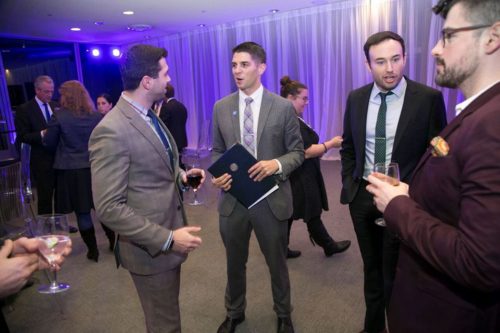Alumni Spotlight is a series of interviews with Model United Nations alumni who are pursuing interesting careers and opportunities after graduation. Today’s interview is with Ryan Kaminski, who was part of the Model UN programs at the University of Chicago and UNA-USA Global Classrooms. Ryan now works as a Senior Program Manager at the United Nations Foundation focusing on human rights issues.
[Kevin Felix Chan]: You participated in college Model UN with the University of Chicago and served as the Director-General of the UNA-USA Global Classrooms International MUN Conference. What was the biggest takeaway from your Model UN career?

Ryan Kaminski at the United Nations
[Ryan Kaminski]: The biggest takeaway was realizing that what I was doing for fun and to make friends actually had very tangible relevance to my post-graduation career, including efforts to market myself as someone with international affairs expertise. Quick example: My first supervisor after college told me that my Model UN experience had a lot of relevance for the job I was about to begin as a Fulbright Fellow in Hong Kong.
Model UN also gives you a strong understanding of complex global issues that goes far beyond just reading an article or two about it on the way to work. You don’t forget a issue easily when you spend hours writing/reviewing a background guide, prepping your position, and debating back and forth about it during a committee session—it sticks with you.
Another benefit from Model UN was learning to adopt a strategic approach that can be applicable in other situations. In Model UN—whether representing the Holy See, Islamic Republic of Iran, United States, Saudi Arabia, or Spain—I had to understand the views of other member states in order to be well-positioned to advance specific priorities. When heading over to the UN for work, I use the same approach in assessing who will be present and how I can best partner with others to move a goal forward.
[KFC]: You’re now a Senior Program Manager at the United Nations Foundation focused on human rights initiatives. What did it take to land a job with the UN Foundation? How did Model UN help?
[RK]: Let’s be candid: The UN’s structure can seem quite complex. My role at UNF requires an ability to not only navigate this complexity, but also communicate strategically with different actors, including UN officials, UN member states, decision-makers on Capitol Hill, the business sector, grassroots human rights organizations, and others.
Model UN provided great experience for my current role. I was not only able to come to UNF with knowledge of the basics of the UN machinery, but also how different actors approach the UN in unique ways. For example, one of my key focus areas at the UN Foundation is the UN Human Rights Council—the top UN human rights organ. I first learned about this body, and its predecessor the UN Human Rights Commission, through Model UN.

Ryan Kaminski speaking at the United Nations
[KFC]: What’s your job as a Senior Program Manager at UNF like?
[RK]: The thing I like most about my job the most is that no two days are alike. A day at work can include anything from working directly with a UN member state on an event, completing research for materials that will be shared on Capitol Hill, meeting with human rights defenders from around the world, or even judging a case study competition in California on the Syrian refugee crisis. Things happen (and can change) fast, and it keeps me busy. With a new U.S. President, U.S. Congress, and new UN Secretary General in office this year, I’m sure this pattern will continue.

Ryan Kaminski at the Social Good Summit
One of my fondest memories was covering negotiations to establish the new UN Sustainable Development Goals (or SDGs) in summer 2014. On the last day of negotiations, talks extended until 2AM in the morning. Some diplomats were obviously getting tired, the trash cans were overflowing, and cash for the UN vending machine had the same value as gold—a diplomat from one of the “P5” even asked if I had any spare change on me. At one point, my colleague and I left the UN briefly to grab a pizza because we hadn’t had dinner yet. As most night clubs were closing in New York, we tore into the pie right in the lobby of UN headquarters. Ultimately, the SDGs were adopted by a consensus of the UN General Assembly—probably assisted by the free-flowing caffeine and carbs that night.
[KFC]: You get to attend UN and NGO conferences all the time. In what ways are those experiences similar or different to MUN?
[RK]: Like Model UN, this kind of travel offers a great opportunity to meet folks from all different backgrounds and places. I’ll never forget a recent LGBTI human rights conference in Montevideo, Uruguay, where I was having lunch with advocates I just met from Belize, Pakistan, and the Philippines. I think one important difference between Model UN and working with UNF is that, unlike traveling with a school’s model UN, sometimes you might be the only the only one from your organization present at a conference. It really elevates the role of networking skills, listening to new ideas, and sometimes getting out of your comfort zone. The good news is that many other people are in the same boat.
One similarity is that there tends to be some form of a “delegate dance” at the end. While there may not be much dancing, these are great social greasers and the opportunity for candid talk. One other similarity—well sort of—is that the UN Third Committee has its own version of superlatives. At the end of the session, certain delegations read poems about what happened during the session. From what I have seen, this tradition is apparently taken quite seriously.

Ryan Kaminski (center) in action
[KFC]: As a professional in solving human rights issues, what advice would you give to Model UN delegates to help them improve their solutions on such topics?
[RK]: Read. Read committee background guides (in full) and see what think tanks have said about a given topic area. Don’t be afraid to contact alumni, professors, or other experts about a topic. They should be excited to help.
Collaborate. On a more tactical level, delegates shouldn’t think they have to stick within your own regional bloc to find allies. I think it’s really time for Model UN background guides to move beyond “bloc” positions based solely on regions. In fact, some of the best solutions that have come from the UN Human Rights Council are a result of cross-regional initiatives, catalytic leadership, and cooperation. The effort to create a new special rapporteur mandate on the “Rights to Freedom of Peaceful Assembly and of Association” in 2010 is a great example of this approach in action, as is the establishment of a “Commission of Inquiry on Human Rights in the Democratic People’s Republic of Korea” in 2013.
Finally, be creative. There are numerous important mechanisms within the UN human rights system that have garnered surprisingly little attention in Model UN. Delegates and conference planners should think about how the treaty bodies, Universal Periodic Review, and elections for the UN Human Rights Council can be better integrated in Model UN. There’s a world of opportunity out there!
[KFC]: Lastly, are there resources from your work that they could research into?
[RK]: Resource Ideas:
The Office of the UN High Commissioner for Human Rights Website: http://www.ohchr.org/EN/pages/home.aspx
Council on Foreign Relations, “Bolstering the UN Human Right’s Council’s Effectiveness” http://www.cfr.org/human-rights/bolstering-un-human-rights-councils-effectiveness/p38621
“Global Governance Monitor: Global Human Rights Regime” Council on Foreign Relations http://www.cfr.org/global-governance/global-governance-monitor/p18985#!/human-rights


